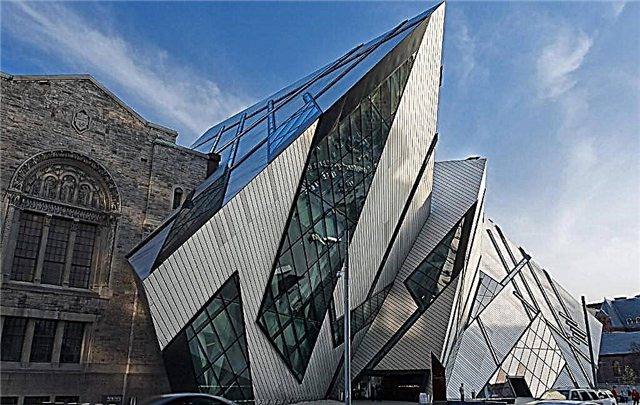Address: Russia, Saint Petersburg, Nevsky prospect
Building: 1738 - 1783
Architect: Domenico Andrea Trezzini
Coordinates: 59 ° 56'08.1 "N 30 ° 19'44.5" E
Object of cultural heritage of the peoples of the Russian Federation of regional significance
Content:
For more than two and a half centuries, the austere buildings of Nevsky Prospect are decorated with an elegant classical basilica. Masses, Christian sacraments and meetings of young people are held in this church. The oldest Catholic church in St. Petersburg attracts not only believers, but also tourists. Travelers come here to admire the beautiful facades and interiors, listen to organ music and the singing of the church choir.

General view of the Catholic Church of St. Catherine
History of the construction of the temple
Russian Tsar Peter I welcomed skilled foreign craftsmen, therefore people of different nationalities and religions took part in the construction of the city on the Neva. In 1716, Catholic townspeople created a religious community in St. Petersburg.
For a long time the believers did not have their own church, but in 1738 Anna Ioannovna signed a document for the construction of a new Catholic basilica. The talented architect Pietro Antonio Trezzini developed the project, but did not manage to implement it. In the spring of 1751, Trezzini was sent from Russia to Italy to work on the rebuilding of the Duke of Milan's palace.

View of the Catholic Church of St. Catherine from Nevsky Prospect
In the 1760s, the French architect Jean-Baptiste-Michel Vallin-Delamot took over the work on the basilica, but the building remained unfinished. Only in the 80s of the 18th century the Italian architects I. Minciani and A. Rinaldi finally completed the long-term construction. The new church was consecrated in honor of the Christian Great Martyr Catherine of Alexandria, and it became a cathedral.
Tsarina Catherine II of Russia considered the saint to be her heavenly intercessor, so she patronized the St. Petersburg Catholics community in every possible way. The Empress invited Archbishop John Andrei Archetti, who was in Russia for the affairs of the Roman Catholic Church, to the consecration of the basilica.
Basilica in the 19th and 20th centuries
Initially, Franciscan monks served in the Catholic church. During the reign of Emperor Paul I, the church was handed over to the Jesuits, and in 1815 the basilica was taken over by the Dominican monks. In 1892 the St. Petersburg church ceased to belong to the Catholic order. The whole life of the parish began to be ruled by priests from the diocese, but the Dominican community survived.

Sculptures of angels holding a cross (in the center) and four sculptures of evangelists on the parapet of the church
At the beginning of the last century, there were about 30 thousand believers in the parish of the basilica. The church nourished the Catholic communities of Germans, French, Poles, Italians, Lithuanians, Latvians and Russians who lived in the city.
After the revolution, the basilica was not closed, but the priests who served there were repressed. In 1923, the rector of the church, Konstantin Budkevich, was accused of creating a counter-revolutionary organization, was tried and shot.
Since 1935, the Dominican monk Michel Florent has served in the basilica. At that time, the French pastor remained the only Catholic clergyman in Leningrad. In 1941, the anti-church campaign did not spare him either. The pastor was arrested and tried. Fortunately, the court-ordered death sentence was commuted to exile to Iran.
When the struggle between the state and religion reached its climax, the masses in the Catholic church were banned, and the church was plundered. In 1938, crosses, icons, liturgical utensils and rare manuscripts were thrown out of the basilica. The huge church library, which contained more than 40 thousand volumes, was completely destroyed.

The inscription above the main entrance ("My house will be called the house of prayer")
The solid building was not demolished, but used as a warehouse and a museum. While it passed from hand to hand, the old German organ and the pictorial image of the Great Martyr Catherine, which was painted by the talented German artist Johann Jacob Mettenleiter, perished.
In the late 1970s, it was decided to convert the building into a philharmonic society, and a large-scale restoration began. In the winter of 1984, the basilica was set on fire. The raging flames destroyed the original interiors, the marble decoration of the altars and everything that the restorers managed to do. A violent fire consumed the exquisite sculptures, stucco moldings, decorations, a large organ body, and colorful wall paintings.
The badly destroyed building remained empty for several years, and stood with clogged windows. In 1992, the long-suffering church was handed over to the community of believers.
The restoration of the basilica took a long time. Some details were restored from old photos and miraculously preserved descriptions. In 2008, the main nave was solemnly consecrated in the church. Then the restorers completely rebuilt the altar part and erected an old cross there.

Church interiors
Temple in the history of Russia
The history of the church, which bears the name of the great martyr Catherine, is associated with the fate of many famous personalities. At the end of the 18th century, the king of Poland and the Grand Duke of Lithuania Stanislav II Augustus Poniatowski was buried in this temple. Since 1988, the remains of the monarch have been buried in St. John's Cathedral in Warsaw.
In 1813, Field Marshal Jean Victor Moreau was buried in the basilica. The famous military leader was mortally wounded by a cannonball in the battle of Dresden. After his death, by order of the Russian Emperor Alexander I, Moro's body was transported to St. Petersburg and a magnificent funeral was held. The modest granite crypt of the Field Marshal can be seen in the crypt of the Basilica.
One of the most famous parishioners of the Catholic Church was the famous architect Auguste Montferrand. Under the vaults of the church, he married his wife and baptized his little son. When the architect died, he was buried in the St. Petersburg Basilica. Then the widow was allowed to transport the coffin home - to France.

Altar of St. Catherine's Church
The church masses were attended by the architect Bartolomeo Rastrelli and the artist Fyodor Antonovich Bruni. Many famous Russian noble Catholics prayed here: the Decembrist Mikhail Sergeevich Lunin, Princess Alexandra Petrovna Golitsyna, Zinaida Alexandrovna Volkonskaya and Prince Ivan Sergeevich Gagarin. In 1859, the future Russian architect and painter Fyodor Osipovich Shekhtel was baptized in the church.
Architectural features
The Catholic Basilica occupies a special place among the cathedrals and temples of St. Petersburg. The beautiful building was built in the tradition of early classicism and has the status of an architectural monument. The temple is built in the form of a Latin cross and measures 44 m by 25 m. The large green dome rises 42 m. The main nave is crossed by a transverse transept.

The yellow front facade with arches and columns faces Nevsky Prospekt. Above, on the parapet, there are figures of angels and sculptures of evangelists holding a cross. Above the entrance portal there are the date of completion of the construction of the temple and an inscription in Latin with a quote from the Gospel.
What can be seen inside
The basilica is quite large, it can hold 2,000 people. The interior is very spacious. The walls and vaults are decorated in white, pale pink and pale green. The soft pastel decor creates an atmosphere of calm and tranquility.
High vaults support rows of columns of the Corinthian order. The Catholic church has excellent acoustics, and a lot of natural light enters the hall through the round windows in the dome.

The old wall of the building preserved during the restoration
Useful information for visitors
Today, the Catholic Church of St. Catherine is the only one in our country that has the honorary title of the Minor Basilica - Basilicae minores. Only those pilgrimage centers and temples of the Roman Catholic Church that play an important role in the history of Catholicism receive this status.The basilica has a Sunday school, a children's center, churching courses, a library and a society for helping the poor.
For tourists and believers, the doors of the temple are open any day from morning to evening. Masses are held daily: on weekdays from 8:30, 12:00 and 19:00, on Saturday - at 8:30, 12:00, 19:00 and 20:00, on Sunday - at 9:30, 10: 45, 12:00, 13:30 and 19:00. In addition to the Russian language, services are held in English, Spanish and Polish.
People come to the basilica to hear beautiful church singing. Every last Friday of the month the Latin Choir sings, and the Liturgica choir accompanies Sunday and festive services. The temple has a Monarke organ, which was formerly located in the Smolny Cathedral. So many people gather for free concerts of organ music that there are no empty seats in the hall.

Fragment of the entrance door of the Church of St. Catherine
How to get there
The Catholic Church is located in the historical center of the city, at 32-34 Nevsky Prospect. The Basilica is located not far from the exits from the Gostiny Dvor metro station.











